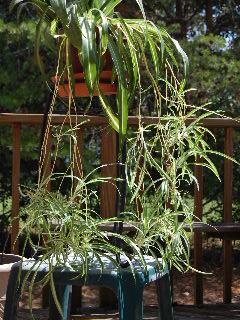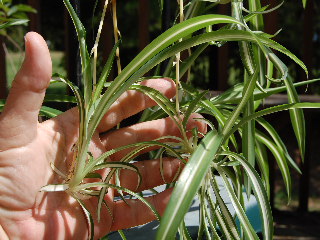
Chlorophytum comosum is the scientific name for the spider plant.
There now—we’ve taken care of the most difficult (and formal) part of our information about this friendly and familiar houseplant. Everything else is easy.
In fact, since we had to choose some category of our website into which we could place the spider plant, we of course chose “Plants” because we don’t yet have a grouping called “Way Too Easy” which is where the spider plant really belongs!
Originally from Africa, spider plant or airplane plant, as it is sometimes called, is so-named because of the “babies” which emerge from the parent plant and appear to be flying out like small airplanes or stretching outward like leggy little spiders.
The plant is most often variegated with a white streak down the middle of the green leaves or a green streak down the middle of pale white leaves, although some varieties do have leaves that are mostly all green.
Spider plant is so undemanding of growing conditions and requires so little pampering, you might think you’re a plant expert (based on the health and vigor of your potted friend), when in reality the plant is doing all the work and all you have to do is admire how good it looks with minimal waterings, filtered light, and occasional feedings of balanced liquid fertilizer!
You can purchase a start of spider plant at your local garden center quite inexpensively, but somehow I think most of the new plants that appear in homes are actually “babies” that have emerged from a plant lover’s pot and have been passed on free of charge to a gardening friend.
In fact, the free-flowing fauna shown in the photographs on this page actually came from a single spider given to us by a kind neighbor just a few summers ago.

And spider plant is an ideal plant to give to young gardeners to stimulate their interest in the green and growing world since the little babies are so easy to care for and fun to watch as they develop and produce offspring of their own.
Don’t fret if your newly potted little spider plant doesn’t immediately start making baby spiders or sending tiny airplanes flying out of the pot. Although some may actually get on with starting a family in just a few months, it’s more likely that 1 to 2 years will be required before the offspring begin to appear.
Just remember the basics—light to moderate watering (the soil can actually be allowed to dry out between waterings) and filtered sunlight. Too much direct sun can burn the leaves.
Spider plant does great in a hanging pot and works perfectly outdoors on your porch, patio, or deck during the warm summer months. It won’t withstand the freezing temperatures of a harsh winter, so plan to bring it indoors to a plant stand or table top near a window where the babies can cascade freely over the edges of the pot.
Spider plant sometimes becomes pot-bound with lots of surface roots crowding the top of the container. Even this state won’t severely restrict the growth of the spider plant, but it does signal that it might be a good time to divide, repot, and clip off the individual babies that can then be rooted into small pots to begin life on their own or be adopted by one of your plant loving friends.
 Chlorophytum comosum is the scientific name for the spider plant.
Chlorophytum comosum is the scientific name for the spider plant.
 And spider plant is an ideal plant to give to young gardeners to stimulate their interest in the green and growing world since the little babies are so easy to care for and fun to watch as they develop and produce offspring of their own.
And spider plant is an ideal plant to give to young gardeners to stimulate their interest in the green and growing world since the little babies are so easy to care for and fun to watch as they develop and produce offspring of their own.